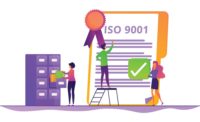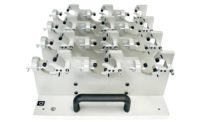It is a moment of pride when getting a university degree, driver’s license, or quality certificate. No other profession has seen as many changes as the quality profession. The quality profession grew into many different disciplines of quality, and the need to recognize the skill came in the 1960s. As a result, quality certification activities started in the late ‘60s became the main thrust of the profession. Over the years quality certification activities grew into many other aspects of quality. Certification background, the process, and benefits are described here.
Quality Certification Background
In the 1960s quality certification activities expanded into many other quality disciplines such as quality engineer, reliability engineer, quality auditor, etc. Auditor and lead auditor certifications came into existence with the introduction of the quality standards by the ISO organization.
Certification proves attainment of a certain level of knowledge for a specific job. Employers can hire certified professionals with confidence. The certification process is an independently verified and prescribed body of knowledge as defined through a combination of education, experience, and examination. Certification is not a license. It is peer recognition of proficiency with a prescribed body of knowledge.
Quality certification is for professionals who know the chosen specialty so well that they can apply the knowledge with known results. The professional knows their own strengths, and the limitation of the specialty. The professional will never turn down an opportunity to further extend the boundaries of knowledge. That knowledge comes with certification. Hence, quality professionals prefer to be certified in the specific discipline.
Certification demonstrates proficiency and understanding of the body of knowledge. It shows a mark of technical excellence. Certification may help in landing a job and increases credibility with customers.
Quality certification is not a license. Certification is obtained from a professional society, whereas license is a legal document obtained from a government authorized administration.
Quality Certification Process
The quality certification process can be complicated as the quality discipline covers many areas such as quality assurance, quality management, quality engineering, reliability engineering, measurement technology, process and product inspection, metrology and calibration, and supplier quality. The quality discipline could be subject related for reliability, measurement, or statistics, or position related such as automotive engineer, aerospace engineer, or metrology engineer.
Team of SMEs (subject matter experts) identify knowledge and tasks required in a variety of industries. Based on industry surveys SMEs identify content to be included in the Body of Knowledge (BoK). SMEs make sure that defined and determined BoK is applicable in industry and all situations. The BoK is extremely broad for certification because it is based on an extensive analysis of a wide sample of representative jobs. After SMEs agree on the BoK, question objectives are developed. From the question objectives multiple-choice questions and answers are developed, which are agreed upon by team members. Answers are confirmed with reference books.
The questions are designed to allow the test-taker to demonstrate ability to apply knowledge to a particular situation. All questions and answers are verified by independent SMEs. Ambiguous questions and answers are removed. Enough questions are generated for the bank, so no question is repeated for the next few examinations. The number of questions from each subtopic, passing score and criteria are determined by a team. A list of reference material (books, available notes, papers, presentations, etc.) is compiled and made available to the examinee for self-study.
A pilot test is given to members to make sure a fair test can be conducted. Examination questions are confirmed to cover the full body of knowledge related to product, process, emerging technology, economy, and particular situations.
BoK is reviewed and revised at certain intervals to determine suitability and adequacy. If warranted, information related to new tools, methods and technology is added to the BoK. After the revision and updates of BoK, new questions are added and outdated ones are discarded. Security of the exam and exam bank gets top priority.
Certification adds value to the certificate holder and in turn the certificate holder can add value to the employer with the acquired knowledge.
Quality Certification Exam
Quality certification process includes passing a multiple choice examination. Each multiple-choice question has only one correct answer. The examination covers questions related to the technical side as well as soft skills such as personality, behavior, verbal, and communication style.
Prior to your examination, study reference books. Attend training classes. Proper understanding of principles and application will help. During the multiple-choice exam, do not dwell on one question for long. Mark the question and come back at the end. In the multiple-choice examination, first delete obviously wrong answers and then select the best answer applicable to the question. Do not spend time finding the answer in the reference book. Examination results are announced and made public. Successful candidates receives a certificate. Feedback from the test takers is important to improve the examination. Certified individuals get recognized and rewarded appropriately.
The certification examination is a method of establishing the quality practitioner’s understanding of the principles of product quality evaluation and control.
Body Of Knowledge (BoK)
Generally, BoK for quality certification may include the following topics and related subtopics:
- General quality management principles and application
- Elements of quality system
- Technical aspects of products and processes
- Statistical process control
- Continuous improvement, corrective and preventive actions
- Data collection and analysis methods
- Risk management
- Quality 4.0 application, tools and methods, automation and robotics
- Education and training
Recertification
Quality certification is a professional status certificate. Unlike a university degree, quality certification is not awarded for life. In order to stay current with technology, tools, methods and avoid knowledge obsolescence, a quality certificate has to be recertified by submitting evidences of ongoing continuing education in the form of 1) Education and new training taken, 2) Teaching, 3) Paper publication and presentation, 4) Active involvement in professional society’s management roles, and 5) Actively engaged in employment.
Auditor certification or lead auditor certification is not the same as quality certification. Auditor or lead auditor certification is obtained from standards accredited registrar bodies.
Benefits Of Quality Certification
Certification is a value creation activity for an individual as well as for the employer. It adds value to the certificate holder and in turn the certificate holder can add value to the employer with the acquired knowledge.
Knowing how to drive is necessary when living in an urban area. Similarly, quality certification becomes essential in an automated digital environment. A certified person can make substantial contributions to the development of quality culture everywhere.
According to the taxonomy developed by Dr. Benjamin Bloom, benefits of certification can be classified as follows:
- Knowledge: Knowledge is gained with the quality certification as one is required to study the material to prepare for the exam. Basic knowledge gained can lead to the next step in career advancement. Sufficient knowledge is acquired during studying that helps advance technology for the benefit of industry.
- Comprehension: when studying new subjects, information is understood and confusion eliminated. It will be easy to find a solution when learning has been absorbed thoroughly.
- Application: It increases ability to apply new material, new methods, and new tools into business environment. It becomes easier to solve complex problems using learned methods, concepts and tools in a difficult situation. Mastery is achieved after the knowledge and understanding have been put into practice.
- Analysis: Data can be organized into easy-to-understand carts and tables. With the analyzed data it becomes easier to observe trends and maverick situations. Future prediction becomes easy.
- Synthesis: Solution is found from the analyzed data to improve the situation. Improvement is achieved with appropriate corrective and preventive actions.
- Evaluation: Learning becomes obvious from this step. Reevaluate the plan for improvements and breakthrough actions. The certified professional has a great opportunity to become a mentor to those entering the profession, and can take a proactive approach in keeping up with technology and new methods and tools. With certification, there is the potential for a higher salary. A certified individual is able to perfect the process and share new techniques and emerging technologies in the workplace
Summary
After university graduation, the next step for learning and advancement is quality certification. The role played by the quality professional in the twenty-first century is quite different from the twentieth century. The quality profession requires systems thinking and a strategic approach. The quality professional now requires knowledge of psychology, software and teamwork.
The future will require knowledgeable quality certificate holders. Personally, I cannot emphasize the importance of quality certification enough. Quality certification is an important qualification to add credibility to the individual.
Navin S. Dedhia (San Jose, CA) is ASQ Fellow, ASQ Certified - CQE, CRE, CQA, CQ MGR/OE. He is recipient of Quality’s 2021 Quality Professional of the Year Award, recipient of the ASQ Distinguished Service Medal and Lancaster Medal. He is also an ASQ inspection division leadership management committee member and editor of the newsletter.




